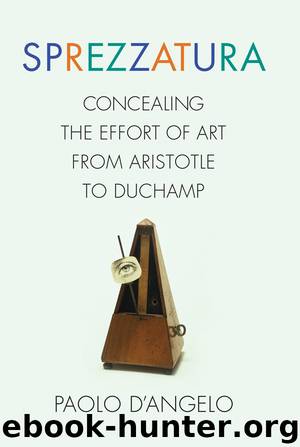Sprezzatura: Concealing the Effort of Art From Aristotle to Duchamp by Paolo D'Angelo

Author:Paolo D'Angelo
Language: eng
Format: epub
Tags: art, Criticism & Theory, History, General, Techniques, Philosophy, Aesthetics
Publisher: Columbia University Press
Published: 2018-03-06T00:00:00+00:00
One gives proof of “the great skill that seems to be the absence of skill” only when the mastering of the void is at play. This “great skill” is characterized by the absence of intentionality and, therefore, of effort; thus a work is completed when the ego is put aside and the efforts disappear; executions reach perfection when the hard exercise on the empty spaces conceals the will and the tension of training. In brief: the “great ability” comes into view when the “small ability” disappears.14
In the modern arts of acting and painting maximum efficacy and perfection are reached when the artist forgets her technique, or better when she has mastered it to such an extent that she can conceal all traces of intentionality and will.
Perhaps the best example of this is offered by a Zen Buddhist text that circulated in Western countries. It is a short book written by a German philosophy professor, Eugen Herrigel, who was appointed to teach at the Imperial University of Sendai in 1924, and who spent more than five years in Japan. The book is titled Zen in der Kunst des Bogenschiessens (Zen in the Art of Archery) and it was published in more than thirty editions.15 Herrigel describes how he wanted to approach Zen through one of the arts, namely, archery, permeated by the spirit of this doctrine that was so distant from European thought. With the help of a university colleague he was accepted as a disciple of one of the most famous masters of archery and, after assuaging the master’s initial suspicions, he began training that lasted until he left the Land of the Rising Sun. Learning archery proved to be very difficult for him. Herrigel was most struck by the master’s insistence that the physical exercise and the concentration of energy required to draw the bow must originate from an absolute ease of movement and be executed without any muscular waste. “When drawing the string you should not exert the full strength of your body,” explains the master, “but must learn to let only your two hands do the work, while your arm and shoulder muscles remain relaxed, as though they looked on impassively.” Even at the point of highest tension, the master’s muscles “were quite relaxed, as though they were doing no work at all,” while the disciple was always too tense and strained. “Relax! Relax!” the master often repeated, just like Chopin reproached “facilement, facilement” when teaching his pupils.16
But for Herrigel this ease of movement and facility were the most difficult thing. “Whenever I tried to keep my arm and shoulder muscles relaxed while drawing the bow, the muscles of my legs stiffened all the more violently, as though my life depended on a firm foothold and secure stance, and as though, like Antaeus, I had to draw strength from the ground.” The bow must be drawn gently and elastically, “with strength and yet without effort.” “The effortlessness of a performance for which great strength is needed is
Download
This site does not store any files on its server. We only index and link to content provided by other sites. Please contact the content providers to delete copyright contents if any and email us, we'll remove relevant links or contents immediately.
Ways of Seeing by John Berger(1293)
The Perfumes The A-Z Guide by Luca Turin(1099)
Rembrandt Drawings by Rembrandt(1088)
The Hare with Amber Eyes by Edmund de Waal(1077)
It's Never Too Late to Begin Again by Julia Cameron(981)
On Photography by Walter Benjamin(930)
Natasha's Dance by Orlando Figes(897)
A Month in Siena by Hisham Matar(867)
Why Architecture Matters by Paul Goldberger(827)
Minor Feelings by Cathy Park Hong(817)
The Sound of Paper by Julia Cameron(815)
0062259628 by Sarah Strohmeyer(815)
The Selected Poetry of Rainer Maria Rilke by Rainer Maria Rilke(815)
0544325265 by Brendan Jones(800)
Citizen: An American Lyric by Claudia Rankine(782)
Proust Was a Neuroscientist by Jonah Lehrer(768)
The Death of the Artist by William Deresiewicz(761)
Perfumes the Guide 2018 by Luca Turin(752)
And Our Faces, My Heart, Brief As Photos by John Berger(725)
